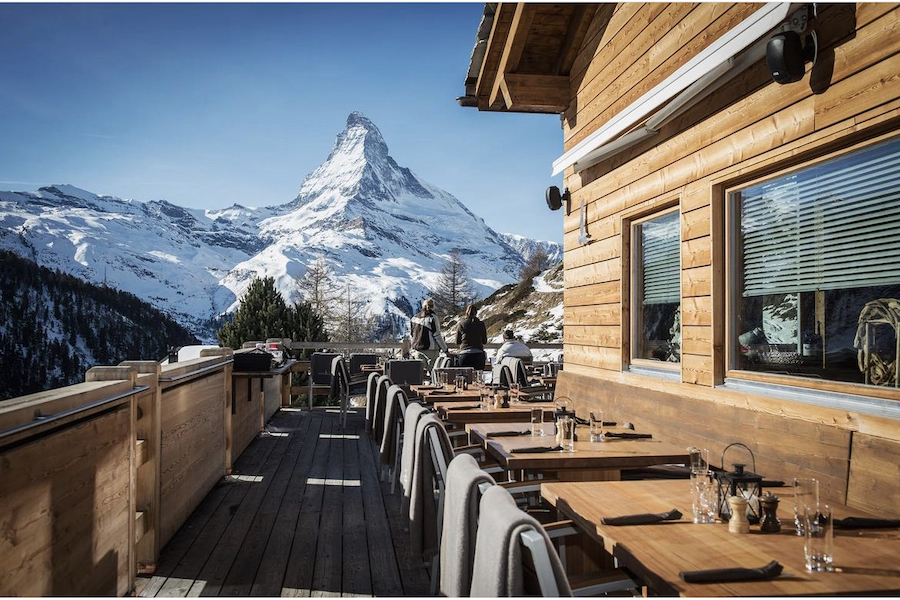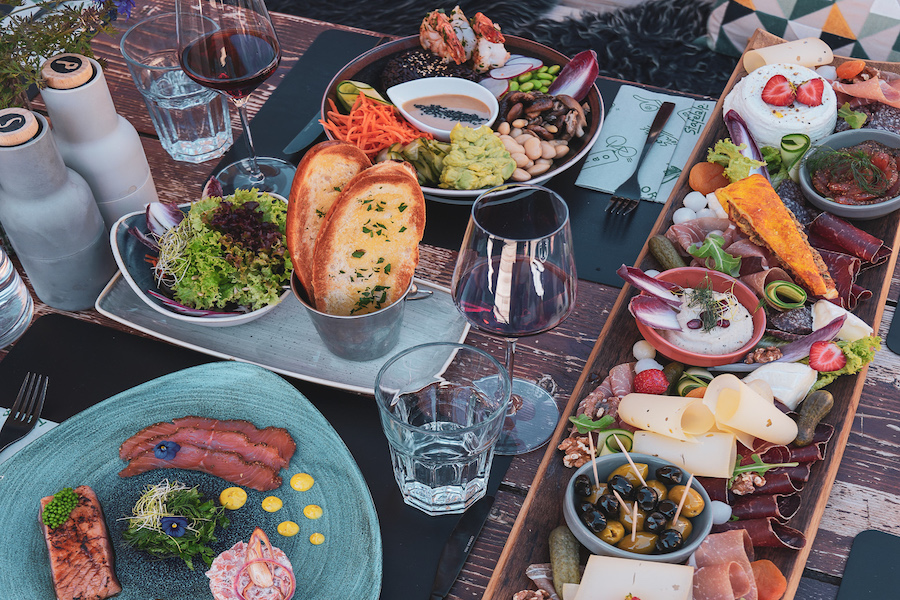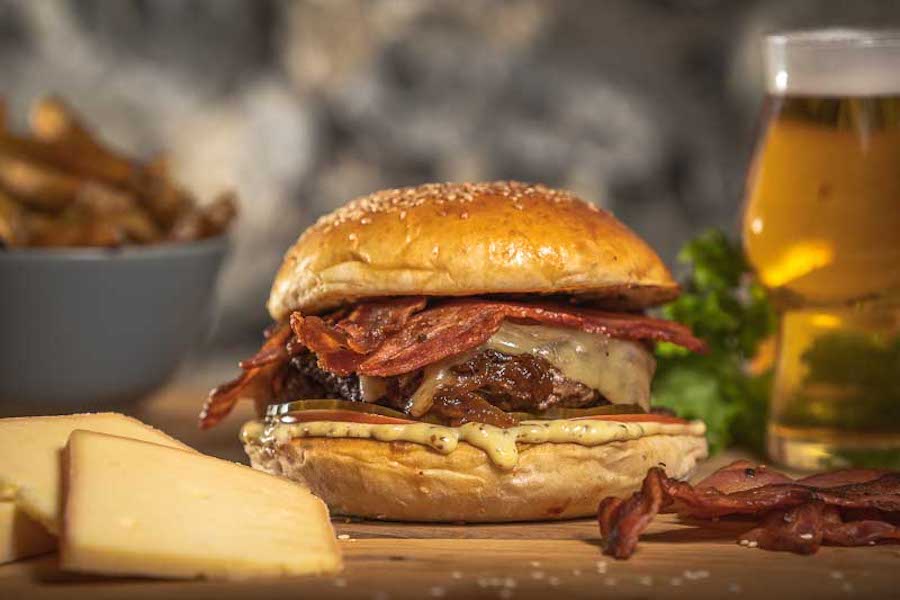Uncover the local's top choice Restaurants in Zermatt for a Unforgettable Gastronomic Adventure!
Don’t know which is the best restaurant in Zermatt to go to? We have put together a handpicked selection of the finest restaurants for you, so you know where to get the best food in Zermatt!
Zermatt is a gastronomic paradise where exceptional dining experiences await you, from sun-kissed terraces with awe-inspiring views, to cozy alpine huts exuding charm.
We have categorized the restaurants by the three main ski areas on the slopes and the village. Then we divided these into:
Whether you're craving Swiss, Italian, Asian, or fine dining cuisine, we have recommendations to satisfy every palate. Join us as we take you on a culinary journey through Zermatt's best restaurants!
Zermatt is famous for having outstanding restaurants right on the slopes and near the hiking trails. No need to head down into the village to get a decent meal! Here are our recommendations for where to eat, sorted into the three mountain areas. In case you are looking for vegetarian options, we gathered our best options in our guide Best vegetarian restaurants Zermatt.
Adlerhitta
Live music, happy faces, good (mulled) wine, beautiful view – the Adlerhitta has it all! If you ask anyone from the local ski-scene, many of them will tell you this is one of the best restaurants in Zermatt. So whenever you are on the Sunnegga side, the Adlerhitta is defently worth a visit for everyone looking for a good meal and a good time!

At the Adlerhitta Zermatt you don't know where to look first: At the breathtaking panorama or the culinary highlights. (© Restaurant Adlerhitta)
Chez Vrony
With 14 Gault Millau points, Chez Vrony is one of the most sought after restaurants in Zermatt. If you want to be sure to get a table, book at least a couple of days in advance! The atmosphere is one of a kind, and you will find live music and happy locals as well as tourists from all around the world.
Fluhalp
Fluhalp is one of the most popular and most frequented restaurants on the slopes of Zermatt. It is situated in a sunny area, so chances are you will be able to sit outside in the sun and enjoy a fantastic view of the vast mountain world.
Pizzeria Rothorn
Feeling like enjoying a top notch authentic Italian pizza on top of a 3100 meters high mountain? As this place is very popular among locals, it is best to book a table if you want to be sure to get a chance to try these pizzas!
Alphitta
If you are looking for great food, great staff and great views, Alphitta is the place to come to! Make sure to reserve a table in advance, so you are guaranteed to have a table.
Ristarante Al Bosco
At the Al Bosco you can taste the Italian and Swiss alpine cuisine. Here you will find a large sun terrace, high quality food and a cozy inside lounge.
Buffet & Bar Riffelberg
This self service restaurant on Riffelberg has a buffet where you can get salads, local soups, desserts and warm, hearty meals like sausages with chips or other Swiss dishes.
Blatten
Restaurant Blatten is a great place for a late lunch! As the slope continues all the way back to Zermatt, skiers and hikers usually pick this spot as the last stop of the day and the start of the famous apres-ski in the winter. The afternoon sun, entertaining music and cheerful staff will make this place worth a visit every day of the week! If you are not skiing, you can take a lovely 1 hour walk from Zermatt to the restaurant. The soups are highly recommended.
Stafelalp
Located under the north face of the Matterhorn this is another place full of great vibes and good food. A great place to get some late afternoon sun and a delicious meal!

What a feast for the eyes! And at the same time you can enjoy a dreamlike view. (© Restaurant Stafelalp)
Testa Grigia
This is a very special pick for a few reasons:
->it is located on the border between Switzerland and Italy. So it can be argued if it is allowed to apear in a list of the best restaurants in Zermatt. You can access it from the slopes leading left of the \"Klein Matterhorn\", so we think it counts.
->The restaurant is a very simple alpine hut, with a lot of character.
->You will find easy low in price (a rarity in Zermatt) sandwiches, cakes and the best hot chocolate. A rarity on Zermatts slopes!
->An breathtaking view of the Swiss and Italian mountain ranges make this a unique place.
Author's Tip: From Testa Grigia you can ski over to the Italian ski resort where a further choice of amazing restaurant awaits you!
Restaurant Zum See
One of Zermatt's restaurants with a Michelin star and 14 Gault Millau points! Heaven for fine diners and wine lovers. Simple, local food executed superbly.
Would you also like to enjoy the view of the Matterhorn from your holiday flat? Almost all Zermatt Holidays accommodation offers you a unique view of the alpine panorama, including the Matterhorn. Book an unforgettable stay with us and benefit from our best price guarante.
Cervo: Bazaar
Restaurant Bazaar is the vegetarian restaurant of the Cervo Resort. You will be greeted with first class food, great atmosphere and if you stay into the late afternoon, you can enjoy the legendary apres-ski party with live music and DJs. You can either take the nice 15 minute walk up to the resort or take the lift from Sunnegga station.
Restaurant Molino
In the centre of Zermatt you can either sit on the sunny terrace or inside and watch the buzzing of the Bahnhofstrasse. The Italian pizza and pasta will leave you full and the prices are in a medium range. Suitable for a family with kids.
Tradition Julen
This is one of the most distinguished restaurants in Zermatt led by a local family. At lunch, you can sit outside on the sun terrace or in the cosy traditionally styled restaurant inside. You will get some of the highest quality meat here, coming from the family’s own cows and sheep, a tradition that has been handed down for generations.
Sonnmatten
In Summer, Restaurant Sonnmatten has the most beautiful outside sitting area, in the quiet and peaceful hamlet Winkelmatten. A playground for kids is just a couple of metres away. In Winter, they usually have a fireplace outside and a lovely inside area. The food and atmosphere is amazing and always worth a visit!
As there are about a hundred restaurants in Zermatt, we have listed our all time favourites below, divided in different categories:
Brasserie Uno
Brasserie Uno is a casual fine dining restaurant with a Michelin star in the centre of Zermatt, and has created a very special dining experience. They use regional and seasonal ingredients, partially grown from their own garden, and recycle food waste into energy. Depending on each season you will get a unique predefined 4- or 6-course menu.
1818 eat drink
In this traditional old chalet house you will dive deep into the best the mountain restaurant experience in Zermatt has to offer. This place is set in the stones of the first hotel in Zermatt and designed by Zermatt most prestigious artist, the atmosphere will let you have an unforgettable evening. The wine bar where you can stay before and after your meal has one of the best range of unique wines in Zermatt.
After 7
In the heart of Zermatt, this Michelin starred restaurant is part of the Vernissage Backstage Hotel. Ivo Adam, one of Switzerland’s top Chefs will indulge your taste buds. If you feel like going out after dinner, a few floors down the Vernissage Bar & Club regularly has very popular events.
As Zermatt history shares a border with Italy and has a long history of migration on both sides, naturally the Italian cuisine is very strong in Zermatt. Here are our absolute favourites:
Restaurant Grampi's
Our favourite go to place for pizza! Apart from the excellent food you are guaranteed a fun time at Grampis. The restaurant has a unique decor and the busy staff is always good fun. If you plan on going out after dinner, you are already perfectly situated at the nightlife hotspot, with bars and clubs on the same street.
Tre Colore (Hotel Albana Real)
Not as well known among tourists, this place is a jewel you will often find not too crowded. The staff is very friendly and the food superb.
Pizzeria Roma
A very popular place, so best to book a table. The restaurant offers excellent Italian food, is near the centre and usually very crowded.
Casa Mia
Right behind the Gornergrat Station, this restaurant is in the centre of the village. They impress guests with a good wine list and high quality food.
Restaurant da Nico
The only flaw restaurant da Nico has, is that it is very difficult to get a table. They are well known for their outstanding Italian food and locals as well as tourists love to dine here!
Golden India
Visitors from all over the world agree: this restaurant has mastered amazing authentic Indian food in the Swiss alps. From Northern India, being famous for its food, the owners have taken their culinary secrets to Zermatt. The Punjabi curry and Tandoori dishes are our favourite picks on the menu.
Fuji (Hotel Albana Real – Sushi)
This Japanese restaurant and Sushi Bar offers fantastic food with entertainment; the chefs will create authentic Teppanyaki on herds in front of your eyes.
China Garden
The only Chinese restaurant in Zermatt, and it has been awarded with 14 Gault Millau points. The chefs from Peking focus on traditional dishes. A good place to go if you are looking for Chinese food.
Myoko (Sushi)
This beautiful Japanese restaurant in the centre of Zermatt offers tasty traditional Japanese dishes. They specialise in Sushi and Teppanyaki.
Cervo: Ferdinand
The restaurant Ferdinand is a fantastic place to go if you want to eat Swiss Fondue or Raclette. Many agree that the Ferdinand is the best restaurant in Zermatt for Fondue and have the best cheese from the region. It is very popular, so be sure to book a table!
Swiss Chalet
The Swiss chalet has all you need for a great diner: friendly staff, delicious Swiss food and medium prices. The atmosphere of an authentic Swiss chalet will bring you into the mountain spirit.
Zermatterstübli
The Zermatterstübli is a good choice when looking for hearty Swiss alpine food. The restaurant is located in the centre of the village at the Bahnhofstrasse. The prices are ranged medium – high.
Walliserstube
A great place for families and friends. This restaurant is a short walk away from the centre, but definitely worth a visit while you are in Zermatt. The friendly staff will make you sure you feel welcome and create a naturally easy going atmosphere.
Schäferstube Hotel Julen
This family owned restaurant has some of the best quality meat in Zermatt and some people say, it is generally one of the best restaurants in Zermatt. The meat comes from their own Valais Blacknose sheep (a breed originated in the region) and Évolène Cows. The place is very popular among locals as well as tourists from all over the world.
Stockhorn by the Rex
The Restaurant Stockhorn values knowing where your meat comes from and selecting their farmers and produce from the region. The interior design is beautiful and very cosy and they cook on an open wood fire.
Le Gitan
A good place to go if you are looking for traditional Swiss grill dishes.
Republic Zermatt
If you are looking for a great burger, this is the best restaurant in Zermatt to go. It is also a bar, so be ready for a lot of young people, a good selection of beer and an easy going fun atmosphere. The prices are on the steeper side (as most places in Zermatt) but absolutely worth it.

Not only does it look delicious, it also tastes insanely good. (© Republic Zermatt)
Brown Cow
The Brown Cow is also a pub and one of the most popular places among locals, so it will usually be very full. They have a good choice of snacks and burgers and the prices are some of the best you will find in Zermatt.
We hope you found this guide to the best restaurants in Zermatt helpful and discovered some great places for you. Enjoy embarking on the journey through Zermatt's exquisite gastronomy. If you want to find the best vegetarian restaurants Zermatt, visit our guide on that.
If you liked this article, you`ll want to check our Zermatt Guide for more information for your stay in Zermatt!
Want us to take care of your table reservations? No problem! Book your Zermatt Rental with us, and it's part of the package! We're all about making your stay unforgettable!
For an elevated Zermatt experience, Zermatt Holidays is your top choice. With over 500+ ⭐⭐⭐⭐⭐ ratings, our guests speak for us. We offer exceptional accommodations and service, from organising your pickup service at the Zermatt train station, to pre-arranging ski passes, ski instructors, train tickets, and so on; we have it covered! Book your stay with Zermatt Holidays and we will ensure you will have an unforgettable Zermatt getaway!
Do not forget to follow us on Instagram or Facebook for daily updates and travel tips!
If you have any questions regarding this article or our holiday rentals please contact us via +41 27 968 11 30 or email us info@zermattholidays.com
© 1999 - 2024 Zermatt Holidays.
phone-square
facebook-square
tripadvisor
instagram